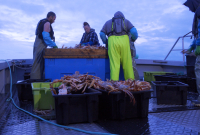Support strong Canadian climate journalism for 2025
Canada’s most valuable commercial fish stocks — such as Iobsters, scallops and snow crabs — will be hit hardest if emissions don’t fall drastically, says a new study.
The study, published in Nature on Wednesday, maps the fate of over 2,000 marine species and 90 fish stocks across the North Atlantic Ocean. It shows that if emissions are not drastically reduced, Canada’s most commercially exploited stocks will suffer the most.
The study examines two scenarios over the next 75 years for marine life in the region. In one, emissions are kept in line with the Paris Agreement target of warming to 1.5 degrees C, while the other shows what will occur if emissions continue to rise.
The high-emissions scenario — called RCP8.5, or business as usual — looks at a future where countries do not make significant changes to cut planet-warming greenhouse gas emissions.
Overall, the paper found that in both scenarios, species in the region are at high or critical risk across about a third of their native geographic distributions. However, if emissions are reduced, many harvested species won’t be as affected. American lobster, Atlantic sea scallop, snow crab, and northern shrimp were all highlighted as species whose habitats are the most affected by climate change because they are closer to shore, and therefore more vulnerable to warming ocean temperatures.
Fisheries such as lobster are important to Atlantic Canada’s economy. Last year, Canadian lobster exports hit $3.26 billion, a record surpassing the previous high of $2.50 billion in 2019.

The study measured risk to species with the Climate Risk Index for Biodiversity tool, explains Katie Schleit, fisheries director at Oceans North and one of the paper’s lead authors.
“[The tool] looks at three different factors: fish or marine species’ future exposure to climate change, its current sensitivity to climate change, and its ability to adapt to climate change,” she said.
“So then, you have a sense of how urgent climate change action is, how great the impacts will be on one particular species.”
“We created a ‘climate scorecard’ that tells us which species, ecosystems, and fisheries will win or lose under climate change,” added Daniel Boyce, an independent researcher and lead author.
That information can help fisheries managers and scientists know when and how to step in. But the challenge is huge, and growing.
Estimates from the UN Educational, Scientific and Cultural Organization find more than half of marine species could be on the brink of extinction by 2100. Each degree of warming has a profound impact on biodiversity in the sea, causing effects that cascade through ecosystems: “A warming of 1.5 C threatens to destroy 70 to 90 per cent of coral reefs, and a 2 C increase means a nearly 100 per cent loss — a point of no return,” writes the UN.
Climate science lacking in DFO decisions
On one hand, the paper presents a grim future: one where emissions continue to rise and fish and other marine life — and the people who depend on them — suffer. As of now, the world is on track to breach the 1.5 degrees C threshold by the late 2020s or early 2030s.
The paper stresses that assessing climate risk to species is key in fisheries management. The more at risk a species is, the more they should be prioritized for action, such as closures and catch reductions, explained Schleit. “We don’t have infinite resources, so how do we prioritize which stocks to act on?”
Schleit co-authored a study in 2021 on how Fisheries and Oceans Canada was implementing climate change into its decision-making. The department received a failing grade. While Schleit notes there has been progress since (for example, science advisory reports now include a section on climate change), the urgency of climate change is not adequately incorporated at the federal decision-making level.
She points to this week’s decision to reopen the cod fishery in Atlantic Canada after a 32-year moratorium as a fisheries management move that doesn’t consider climate change impacts. The study found Atlantic cod is at high risk of climate change impacts, “but we didn't see that sort of information inform the decision,” notes Schleit.
While the current warming trajectory cannot be downplayed, the report also maps out an urgent call to action to lower emissions.
“If we're able to look to lower emissions, we're lowering the impact on marine species in this region [and] we're lowering the impact on our commercially important species in particular,” she noted.
Separate from the emissions scenarios, the report provides valuable information about the climate impact on fisheries, which could be used to make less reactive decisions. Instead of waiting for a stock to dwindle to dangerous lows, proactively planning for climate impacts on fisheries would help protect species, Schleit said.
“The ocean is already changing,” she said. “As the northwest Atlantic warms, fisheries management needs to take the whole ecosystem into account — including climate data — so that we can adapt to new situations and protect vulnerable species.”






Comments